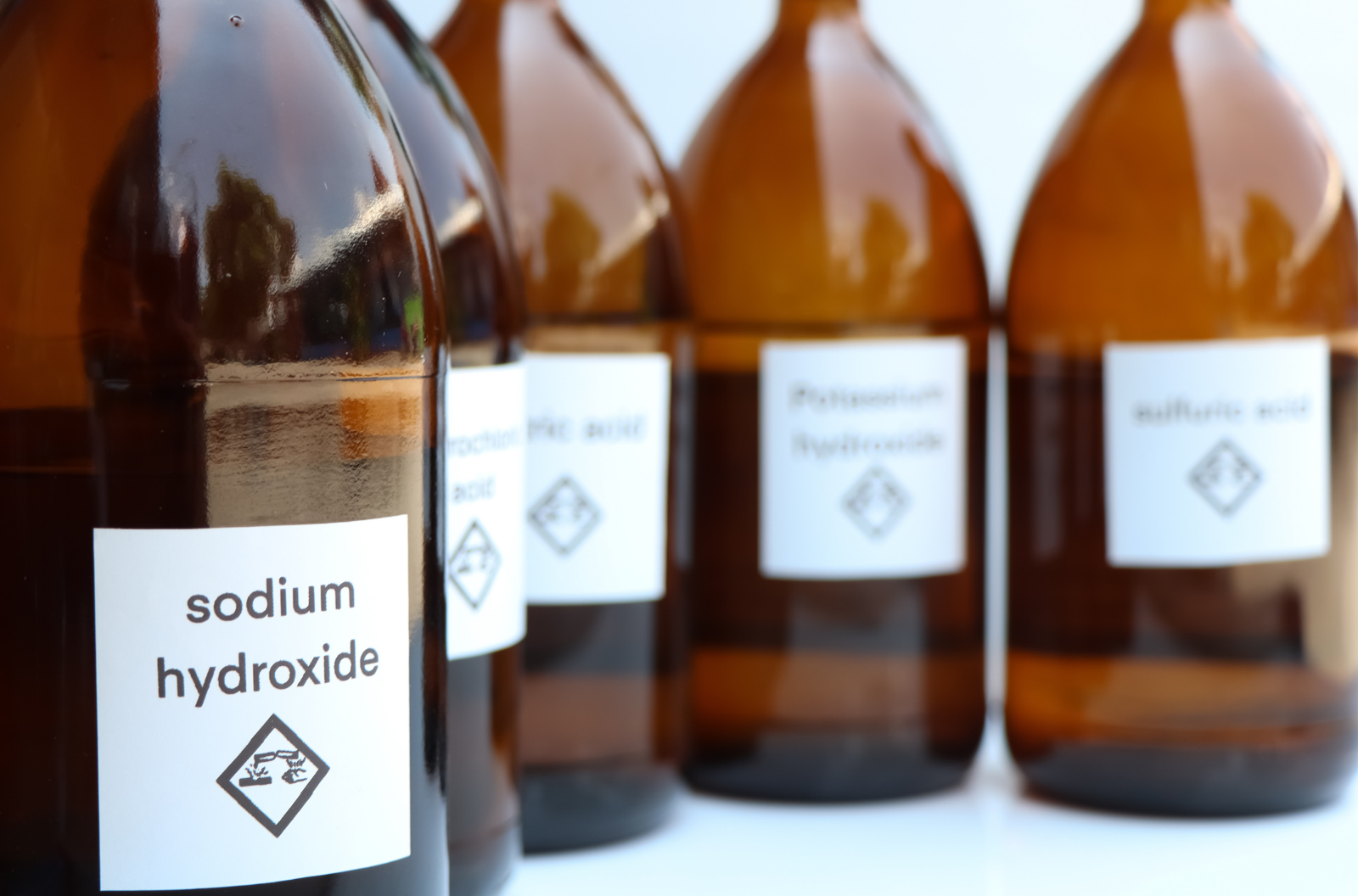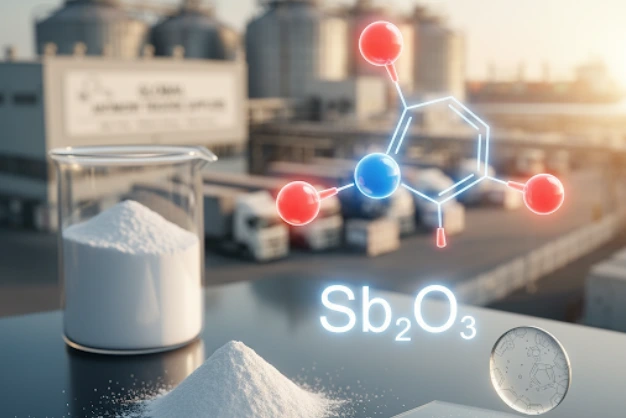TABLE OF CONTENTS
TABLE OF CONTENTS
What is Sodium Hydroxide?
Sodium Hydroxide, also known as lye or caustic soda, is a highly caustic inorganic compound with the chemical formula NaOH. It appears as a white solid and is highly soluble in water, creating a strong alkaline solution. Sodium Hydroxide is widely used in various industries due to its reactivity with acids, metals, and organic compounds. Common applications include the production of paper, textiles, soaps, and detergents, as well as water treatment and petroleum refining. Due to its corrosive nature, handling Sodium Hydroxide requires strict safety measures, such as using protective gloves and goggles to prevent severe burns and other injuries.
Chemical Composition and Key Properties of Sodium Hydroxide
Chemical Formula and Structure of Sodium Hydroxide
Chemical Formula (NaOH)
Sodium Hydroxide, commonly known as lye or caustic soda, has the chemical formula NaOH. This compound consists of one sodium (Na) atom, one oxygen (O) atom, and one hydrogen (H) atom. The formula indicates a 1:1:1 ratio of sodium, oxygen, and hydrogen elements.
Molecular Structure and Bonding
Sodium Hydroxide is an ionic compound. The sodium ion (Na+) is positively charged, and the hydroxide ion (OH-) is negatively charged. The bond between these ions is ionic, resulting from the electrostatic attraction between the positively charged sodium ion and the negatively charged hydroxide ion. This ionic nature gives NaOH its characteristic properties.
Physical Properties of Sodium Hydroxide
Appearance
Sodium Hydroxide typically appears as a white, crystalline solid. It can also be found in pellet, flake, or granular form.
Melting Point
Sodium Hydroxide has a melting point of approximately 318°C (604°F).
Boiling Point
The boiling point of Sodium Hydroxide is around 1,388°C (2,530°F).
Solubility
Sodium Hydroxide is highly soluble in water, where it readily dissolves to form a strongly alkaline solution. It is also soluble in ethanol and methanol, but insoluble in non-polar solvents like ether and hydrocarbons.
Physical State at Room Temperature
At room temperature, Sodium Hydroxide is usually in a solid state. When dissolved in water, it forms a highly exothermic solution, meaning it releases a significant amount of heat.
Chemical Properties and Reactivity of Sodium Hydroxide
Reactivity with Acids, Metals, and Other Substances
Reactivity with Acids: Sodium Hydroxide reacts vigorously with acids in a neutralization reaction, producing water and a salt. For example, reacting NaOH with hydrochloric acid (HCl) yields water (H2O) and sodium chloride (NaCl).
NaOH + HCl → NaCl + H2O
Reactivity with Metals: Sodium Hydroxide reacts with certain metals like aluminum and zinc, releasing hydrogen gas. For example, its reaction with aluminum forms sodium aluminate and hydrogen gas.
2Al+2NaOH+6H2O→2NaAlO2+3H2
Reactivity with Other Substances: Sodium Hydroxide reacts with various organic compounds, including esters, amides, and fats, typically resulting in saponification, a process used in soap making.
Exothermic Reaction When Dissolved in Water
When Sodium Hydroxide dissolves in water, it undergoes a highly exothermic reaction. This means that the dissolution process releases a significant amount of heat. The equation for this reaction is:
NaOH(s) → Na+(aq) + OH−(aq)
This exothermic reaction can cause the solution to heat up rapidly, which needs to be handled with care to avoid burns or other injuries.
By understanding these properties and behaviors, one can safely and effectively use Sodium Hydroxide in various industrial and laboratory applications.
Production Methods and Synthesis of Sodium Hydroxide
Industrial Production Methods for Sodium Hydroxide
Electrolysis of Sodium Chloride (Chloralkali Process)
The primary industrial method for producing Sodium Hydroxide is the electrolysis of sodium chloride (NaCl), commonly known as the Chloralkali process. This method involves passing an electric current through a brine solution (saltwater), which results in the production of three main products: chlorine gas (Cl2), hydrogen gas (H2), and Sodium Hydroxide (NaOH).
Process Overview
2H2O + 2e− → H2 + 2OH−
2Cl− → Cl2 + 2e−
Advantages
Other Methods of Production
From Sodium Carbonate: Another method of producing Sodium Hydroxide is by reacting sodium carbonate (Na2CO3) with calcium hydroxide (Ca(OH)2) in a process known as causticizing. The chemical reaction is as follows:
Na2CO3 + Ca(OH)2 → 2NaOH + CaCO3
Process Overview
Advantages
Purification Processes for Ensuring Pure Sodium Hydroxide
Methods Used to Ensure the Purity of Sodium Hydroxide
Ensuring the purity of Sodium Hydroxide is crucial for its use in various applications. Several purification processes are employed to achieve high-purity NaOH:
Evaporation and Crystallization
Filtration
Ion Exchange
Chemical Purification
These purification processes ensure that the final product is of high purity, making it suitable for use in sensitive applications such as pharmaceuticals, food processing, and various chemical industries.
Diverse Applications and Uses of Sodium Hydroxide
Major Industrial Applications of Sodium Hydroxide
Sodium Hydroxide (NaOH) is a critical component in many industrial processes due to its strong alkaline properties and reactivity.
Chemical Manufacturing
Petroleum Industry
Textile Industry
Water Treatment
Soap and Detergent Production
Common Household Uses of Sodium Hydroxide
Sodium Hydroxide is commonly found in several household products due to its effectiveness in cleaning and maintenance.
Drain Cleaners
NaOH is a major component in many drain cleaning products. It dissolves grease, hair, and other organic materials that clog pipes, restoring proper drainage.
Oven Cleaners
Sodium Hydroxide is used in oven cleaners to break down and dissolve baked-on grease and food residues, making cleaning easier and more effective.
Soap Making
In small-scale or homemade soap making, Sodium Hydroxide is used to saponify fats and oils, creating bar soaps for personal use.
Paint Strippers
NaOH is used in some paint removers to strip paint from surfaces, preparing them for repainting or refinishing.
Significance of Sodium Hydroxide in Laboratories
In laboratory settings, Sodium Hydroxide plays a vital role in various chemical analyses and preparations.
Titration
NaOH is frequently used as a titrant in acid-base titrations due to its strong base properties. It helps determine the concentration of acidic solutions.
pH Adjustment
Sodium Hydroxide is used to adjust the pH of solutions in biochemical and chemical experiments, ensuring optimal conditions for reactions.
Reagent Preparation
It is used in preparing various reagents and solutions required for analytical chemistry and other experimental procedures.
Cleaning and Sterilization
Sodium Hydroxide solutions are used to clean and sterilize laboratory equipment, removing organic residues and contaminants effectively.
Medical and Pharmaceutical Uses of Sodium Hydroxide
Sodium Hydroxide also finds applications in the medical and pharmaceutical fields.
Pharmaceutical Manufacturing
NaOH is used in the synthesis of various pharmaceutical products, including medications, where it acts as a reactant or pH adjuster.
Medicine Production
It is involved in the production of aspirin and other drugs, where precise pH control is essential for the stability and efficacy of the products.
Medical Equipment Sterilization
Sodium Hydroxide solutions are used to sterilize medical equipment, ensuring they are free from microbial contamination.
Tissue Processing
In histology, NaOH is used to process and prepare tissue samples for microscopic examination, ensuring clear and precise observations.
By understanding these diverse applications and uses, it becomes clear why Sodium Hydroxide is such a valuable and widely used compound in various industries, households, laboratories, and medical fields.
Safety Measures and Handling Guidelines for Sodium Hydroxide
Understanding the Health Hazards of Sodium Hydroxide
Sodium Hydroxide (NaOH) is a highly caustic substance that can cause severe damage to human tissue upon contact. Understanding the health hazards associated with NaOH is crucial for safe handling and use.
Skin Contact
Direct contact with Sodium Hydroxide can cause severe burns, blisters, and permanent tissue damage. It can lead to deep, painful wounds that may take a long time to heal.
Eye Contact
If NaOH comes into contact with the eyes, it can cause immediate pain, severe irritation, and potential blindness. Eye exposure requires immediate flushing with water and urgent medical attention.
Inhalation
Inhaling Sodium Hydroxide dust or mist can irritate the respiratory tract, causing coughing, difficulty breathing, and even pulmonary edema in severe cases.
Ingestion
Swallowing Sodium Hydroxide can cause burns to the mouth, throat, esophagus, and stomach. It can result in severe pain, vomiting, and potentially life-threatening injuries.
Essential Safety Precautions for Handling Sodium Hydroxide
To minimize the risks associated with Sodium Hydroxide, several essential safety precautions must be followed.
Personal Protective Equipment (PPE)
Gloves: Wear chemical-resistant gloves, such as those made from nitrile, neoprene, or rubber, to protect the skin.
Eye Protection: Use safety goggles or a face shield to prevent eye contact.
Clothing: Wear long sleeves, pants, and an apron made from chemical-resistant material to protect the skin.
Respiratory Protection: Use a respirator with appropriate cartridges if there is a risk of inhaling NaOH dust or mist.
Safe Handling Practices
Storage: Store Sodium Hydroxide in a cool, dry, well-ventilated area away from incompatible substances such as acids. Ensure containers are properly labeled and tightly sealed.
Handling: Always handle NaOH with care. Avoid generating dust and do not breathe in vapors or mist. Use tools and equipment made from materials resistant to corrosion by NaOH.
Spill Management: In case of a spill, contain and neutralize it with a weak acid like vinegar or citric acid. Use appropriate absorbent materials and dispose of them according to local regulations.
First Aid Measures
Skin Contact: Immediately rinse the affected area with plenty of water for at least 15 minutes. Remove contaminated clothing and seek medical attention.
Eye Contact: Flush the eyes with water for at least 15 minutes, lifting the upper and lower eyelids occasionally. Seek immediate medical attention.
Inhalation: Move the person to fresh air immediately. If breathing is difficult, provide oxygen and seek medical attention.
Ingestion: Do not induce vomiting. Rinse the mouth with water and seek immediate medical attention.
Environmental Impact and Safety of Sodium Hydroxide
Sodium Hydroxide can also pose environmental risks if not handled and disposed of properly.
Environmental Hazards
Environmental Safety Measures
Emergency Response
By understanding the health hazards, implementing essential safety precautions, and being aware of the environmental impact, Sodium Hydroxide can be handled safely and responsibly in both industrial and household settings.
Regulatory and Compliance Information for Sodium Hydroxide
Regulatory Standards for Sodium Hydroxide
Sodium Hydroxide (NaOH) is subject to various regulatory standards to ensure its safe handling, use, and disposal. These standards are set by national and international agencies to protect human health and the environment.
Occupational Safety and Health Administration (OSHA)
Permissible Exposure Limit (PEL): OSHA has established a PEL for Sodium Hydroxide of 2 mg/m³ as a ceiling limit, meaning that this concentration should not be exceeded during any part of the workday.
Hazard Communication Standard (HCS): OSHA’s HCS requires that Sodium Hydroxide be classified as a hazardous chemical and mandates proper labeling and the provision of Safety Data Sheets (SDS) to communicate the hazards to workers.
Environmental Protection Agency (EPA)
Resource Conservation and Recovery Act (RCRA): Under RCRA, Sodium Hydroxide is classified as a hazardous waste if it exhibits corrosive properties. Specific guidelines for its disposal are provided to prevent environmental contamination.
Clean Water Act (CWA): The EPA regulates the discharge of Sodium Hydroxide into water bodies to prevent water pollution. Facilities must obtain permits and follow strict guidelines to ensure safe discharge levels.
European Chemicals Agency (ECHA)
Registration, Evaluation, Authorisation and Restriction of Chemicals (REACH): Under REACH, Sodium Hydroxide must be registered, and safety information must be provided to ensure its safe use within the European Union. Companies must comply with the guidelines for handling and disposing of NaOH.
Globally Harmonized System of Classification and Labelling of Chemicals (GHS)
The GHS provides a standardized approach to classifying and labeling chemicals, including Sodium Hydroxide. It ensures that the hazards are communicated consistently across countries. Sodium Hydroxide is classified as a skin and eye irritant, and appropriate hazard pictograms and precautionary statements must be used.
Labeling and Packaging Requirements for Sodium Hydroxide
Proper labeling and packaging are essential to ensure the safe transportation, storage, and use of Sodium Hydroxide. Regulatory agencies have established specific requirements to mitigate risks associated with its handling.
Labeling Requirements
Packaging Requirements
Documentation
By adhering to these regulatory standards and labeling and packaging requirements, companies can ensure the safe and compliant handling, use, and disposal of Sodium Hydroxide, thereby protecting human health and the environment.
Conclusion
Sodium Hydroxide (NaOH) is a versatile and essential chemical used across various industries and applications, from manufacturing and water treatment to household cleaning and pharmaceuticals. Understanding its chemical properties, production methods, applications, and safety measures is crucial for its effective and safe use. Adhering to regulatory standards and ensuring proper handling, labeling, and disposal practices protect both human health and the environment. By following these guidelines, Sodium Hydroxide can be utilized efficiently and responsibly in numerous industrial, household, and scientific contexts.
FAQs
What is the formula of Sodium Hydroxide?
The formula of Sodium Hydroxide is NaOH.
What is the molecular weight of Sodium Hydroxide?
The molecular weight of Sodium Hydroxide is 40.00 g/mol.
What is the molar mass of Sodium Hydroxide?
The molar mass of Sodium Hydroxide is 40.00 g/mol.
What is the pH of Sodium Hydroxide?
A 1 M solution of Sodium Hydroxide has a pH of approximately 14.
What neutralizes Sodium Hydroxide?
Sodium Hydroxide can be neutralized with acids such as hydrochloric acid (HCl) or vinegar (acetic acid).
What is the density of Sodium Hydroxide?
The density of solid Sodium Hydroxide is 2.13 g/cm³.
Can you mix Sodium Hydroxide and bleach?
No, mixing Sodium Hydroxide with bleach can produce dangerous chlorine gas.
What is a common name for Sodium Hydroxide?
A common name for Sodium Hydroxide is lye or caustic soda.
What color is Sodium Hydroxide?
Sodium Hydroxide is typically white in color.
What products contain Sodium Hydroxide?
Products that contain Sodium Hydroxide include drain cleaners, oven cleaners, soaps, and detergents.
What is the chemical formula for the base Sodium Hydroxide?
The chemical formula for the base Sodium Hydroxide is NaOH.
Contact Us
Questions or looking for a quote?





